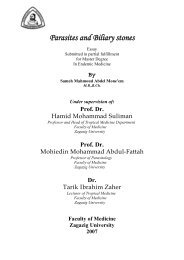E. Coli
E. Coli
E. Coli
Create successful ePaper yourself
Turn your PDF publications into a flip-book with our unique Google optimized e-Paper software.
Review of Literature<br />
Osman (1992) collected 150 random, samples from different<br />
broiler farms at Sharkia Government she found that 45 stains were<br />
positive for salmonella species with an incidence of 30%. Serological<br />
typing of the isolated salmonella species revealing 21 (46.7%) were S.<br />
pullorum, 9 (20%) were S.gallinarum, 7 (15.6%) were S.typhimurium<br />
and 8/17 were not identified.<br />
Draz et al. (1996) examined 60 water and 45 litter samples from<br />
poultry environment and farms. Salmonella species was isolated with<br />
the frequency of 1.7% (1/60) and 2.2% (1/45) respectively. The<br />
isolated water borne strain was identified as S. typhimurium.<br />
Rusul et al. (1996) estimated the prevalence of salmonella<br />
species among broilers retailed at wet markets and processing plants<br />
in Malaysia. A total of 158 out of 445 (35.5%) and 52 out of 104<br />
(50%) broiler carcasses obtained from wet markets and processing<br />
plants were contaminated with Salmonella species respectively.<br />
Salmonella species was isolated from 14 out of 98 (14.3%) samples of<br />
intestinal content. Litter sample from broiler and breeder farms were<br />
positive for Salmonella species with the frequency of 8/40 (20%) and<br />
2/10 (20%), respectively. Examined breeder, broilers and layers<br />
flocks, Salmonella species were recovered from litter sample (42%),<br />
water in drinking troughs (36%), feed left over in feed trays (28%),<br />
water in the main tanks (17%), cloacal swabs (13%) and stock feed<br />
(8%).<br />
12
















